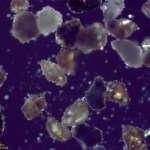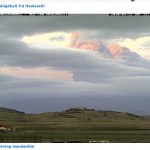Ash fall
Classes starting today, so I have to be brief:
Unique twin ash plumes from Sinabung in Indonesia, erupting on August 29, 2010.
Sinabung
The Indonesian volcano continues to experience explosions, which one last night (well, last night here in Ohio) that prompted an ash advisory for aircraft up to 6,100 m / 20,000 feet, although most reports I've seen pegged the ash column at closer to 2,000 m / ~6,500 feet. Eruptions readers have found a bevy of links for footage and information about the eruption, including a remarkable image gallery from the BBC that shows the volcano exhibiting two ash…
Sinabung on Sumatra erupting on August 29, 2010.
Eruptions readers were quick on the news about the new eruption at Sinabung in Indonesia. There isn't much known about the eruptive history of the volcano - checking out the Global Volcanism Program, the last activity at Sinabung might have been an explosive event in 1881 with persistent fumaroles up until 1912. However, most news sources are quoting 400 years as the last known eruption of the volcano, apparently information from the Indonesian government.
The eruption itself appears to be an ash-rich explosion with ash fall reported up to 30…
Today was a doubleheader for volcanic eruptions in the news:
Today's explosive eruption from Mt. Etna. Image courtesy of the INGV.
As I briefly mentioned earlier, Galeras in Colombia had an "atypical" eruption - apparently meaning it was non-explosive - that has prompted evacuations and a change in the alert status to "Red" for the volcano. Various news sources don't have a lot of new information yet, but you can check on the report on the INGEOMINAS page (spanish) - and they have links to some of the Galeras news (audio, spanish) from their main page. Some of the latest reports from…
Just a reminder, if you any questions for Sally Kuhn Sennert of the Smithsonian/USGS Global Volcanism Program - about the Weekly Report, about life at the GVP, about volcanoes - be sure to send them to me soon at .
Now, on to this week's update!
Some highlights (not including Gorely):
Lahars from Tungurahua in Ecuador moved blocks upwards of 2 m in diameter downstream over the last week and ash fall was reported over 20 km from the volcano's vent. For some reason, FoxNews decided to use an image of Tungurahua for an article on stats of natural disasters in 2009 - nice image, but the volcano…
News for Monday!
Ngauruhoe in New Zealand, showing the dark lava flows of basaltic andesite on the slopes of the young volcanic cone. Image by Erik Klemetti, taken January 2009.
A couple pieces of news from two Russian volcanoes on the Kamchatka Peninsula: (1) last week's report of activity at Gorely appears to be semi-substantiated with new photos on the KVERT website (Russian). The images from June 6 and 12 (2010) shows steam plumes coming from the volcano - one as tall as 500 meters. Now, this doesn't imply that an eruption occurred, but it might suggest activity on on the upswing. KVERT…
The crater lake at Eyjafjallajökull as seen on June 11, 2010. Image from the Icelandic Met Office by Sveinn Brynjólfsson.
After keeping us transfixed for almost two months this spring, Eyjafjallajökull has slowly drifted from the headlines. However, this doesn't mean that interesting things - volcanologically-speaking - have stopped happening at the Icelandic volcano. For one, a crater lake has now been spotted at the summit vent of the volcano. This lake is steaming vigorous, but at the end of last week, the Icelandic Meteorological Office and the Institute of Earth Sciences declared…
The latest update from the Smithsonian/USGS Global Volcanism Program!
Highlights (not including Taal, Eyjafjallajökull and Bezymianny) include:
Another thermal anomaly was spotted on an Kuril Island volcano - this one being Tiatia. The volcano has no seismic monitoring network, so the thermal anomaly is all that has been observed.
Lava flows and strombolian explosions continue at Guatemala's Pacaya. Some of the explosions have launched bombs hundreds of meters into the air.
Kliuchevskoi was another busy Russian volcano, with a large thermal anomaly and ash explosions that produced a plume…
The level of news-frenzy on some of the recent volcanic eruptions has died down, but if you're looking to see information on the many rumbling going on worldwide, look no further. Here is this week's Volcanic Activity Report put together by Sally Kuhn Sennert of the Global Volcanism Program.
Highlights - not including Pacaya, Yasur, Tungurahua and our friend in Iceland - include:
The eruption in the Marianas apparently came from South Sarigan volcano - at least according to the best guess by folks who work in the Marianas. This submarine volcano apparently shows evidence of young lava flows…
Tungurahua in Ecuador erupting on May 31, 2010.
Two volcanoes along the edge of the north Pacific had explosive eruptions over the weekend. We have some more details on both of the eruptions, so I'll pass them on:
Bezymianny
KVERT is excited because they claim to have predicted the explosive eruption of Bezymianny almost to the day. They had been closely monitoring the volcano and issued this statement on May 20:
According to satellite data by AVO and KVERT staff, a temperature of
the thermal anomaly over the lava dome of Bezymianny volcano began
increasing from May 19 (from -1 (9:49 UTC) to…
Undated image of Bezymianny in Kamchatka.
Eruptions reader M. Randolph Kruger just let us in on a significant eruption at Bezymianny in Kamchatka. The AVO/KVERT alert for the volcano suggests a fairly significant explosive eruption that might cause some snarls in the international air travel over the Kamchatka Peninsula. The KVERT statement:
A strong explosive eruption of Bezymianny volcano occurred from 12:34 till 12:50 UTC on May 31, according to seismic data. Ash fall in Kozyrevsk village is continuing. The volcano obscured by clouds. A big ash cloud remains over Kamchatka at present (…
Quick news on Memorial Day (in the US at least):
Ash soaked by rain from Tropical Storm Agatha on the roofs of homes in Guatemala after the late May eruption of Pacaya.
Sixteen scientists were evacuated from islands in the northern Marianas due to the eruption of the unnamed submarine volcano south of Sarigan Island. The eruption is continuing to be monitored closely by the USGS and National Weather Service as the plume - which is most steam with minor ash - could disrupt air traffic in/around Saipan. The latest USGS CNMI update:
Seismicity at a single nearby station on Sarigan Island…
Dark ash covers an American Airline 737 on the tarmac at the airport in Guatemala City.
Two volcanoes are making headlines right now (and neither is in Iceland).
As I mentioned yesterday, Pacaya in Guatemala erupted (video) causing widespread disruption of life in the nearby Guatemala City and costing two people their lives (including a TV reporter who got too close to the vent). Almost 2,000 people have been evacuated from the region near the volcano. The BBC has posted some impressive video of the eruption of Pacaya, showing the strombolian explosions sending basaltic tephra high into the…
This week has been destroyed by workshops and my last death throes with a paper I am submitting on my research in New Zealand. And to think, I thought it might settle down a little after the students left.
To news!
Ash fall on a taxi cab near Guatemala's Pacaya.
Pacaya in Guatemala erupted yesterday causing evacuations of people near the volcano and the closure of Guatemala City's main airport. Pacaya is a mere ~25 km from the capitol of this Central American nation. Tragically, a news reporter from one of the capitol's TV stations died when they were struck by volcanic debris, again…
Brief news!
Lava flows reaching the sea at Kilauea in Hawai`i. Image from November 2009, courtesy of HVO/USGS.
The Alert Status at Cleveland in the Alaskan Aleutian Islands was raised to Yellow (Advisory) by the Alaska Volcano Observatory after new signs of activity emerged. The latest report from AVO on the volcano says a thermal anomaly has been spotted at the summit, which typically is one of the first signs that the volcano is entering an eruption period. However, there is no real-time seismic monitoring for Cleveland, so that is the only clue (right now) that AVO has. Cleveland is a…
For all of you going into withdrawal now that Eyjafjallajökull seems to have quieted down, there are two eruptions of note that aren't in the North Atlantic:
Undated image of the Barujari cone at Mt. Rinjani in Indonesia.
Arenal in Costa Rica - which is almost always sputtering away - had a more significant explosive and effusive event today. The volcano produced enough ash, bombs and gas emissions - along with 8 lava flows (or avalanches, depending on the source) - to prompt the evacuation of the National Park around the volcano. Arenal has had numerous strombolian eruptions over the last…
The ash plume from Eyjafjallajökull, piercing the cloud deck above the volcano. Image courtesy of the Icelandic Met Office, taken on May 13, 2010. See the latest report on the eruption.
With all the rapid fire news on eruptions as of late, combined with my busy schedule during the school year, I haven't been able to post as many articles on some basic aspects of volcanology. I will try to remedy some of this over the summer and the first will look at volcanic ash and specifically the ash from Eyjafjallajökull. I've taken some photomicrographs of the ash from Eyjafjallajökull (sent to me…
News, news, news!
Ash from Eyjafjallajökull piling up on a roof at Seljavellir. Image courtesy of the IMO, by Ari Tryggvason.
The latest from Eyjafjallajökull has the volcano continuing to puff away - producing intermittent airspace closures over Europe. The Icelandic Met Office reports a ~7 km (21,000 foot) ash plume, but they note that the explosivity of the eruption seems to have waned some since a maximum on May 13. Right now, the IMO estimates the eruption rate at ~200 tonnes/second. Lets put that in a little perspective - a Ford F-150 pickup weighs about 2 tonnes, so the volcano is…
Some news for a sleepy Monday:
Mt. Hood in Oregon.
The ash from Eyjafjallajökull is, once again, causing significant airspace closure over northern Europe - close of 1,000 flights today. However, much of the closures are fairly short-lived, but that isn't keeping people happy. The eruption hasn't actually changed much, just that the winds are bringing ash towards Europe. The ash for the next few days will likely effect the England, Scotland, Ireland, Netherlands, France and possibly other parts of northern Europe (along with airspace over Greenland and the north Atlantic). The ash plume is…
Time to play a little catch up ...
Eyjafjallajökull erupting in early May. Image by and courtesy of Martin Rietze.
A brief update on our friend Eyjafjallajökull - the eruption plume from the volcano was considerably taller yesterday, reaching 6-9 km (20,000-30,000 feet), but prevailing winds meant the ash hazard was confined to areas in the middle of the North Atlantic and northern parts of the British Isles. However, even as the ash hazard for Europe wanes (for now), you shouldn't forget the amount of ash being dumped on parts of Iceland. If you want to see some stunning images of the…
An aerial view of Eyjafjallajökull erupting on May 11, 2010, with the extent of the black ash from the eruption on GÃgjökull clearly evident, along with the cracks in the glacier near the lava flow. Photo from the Icelandic Met Office, by Sigurlaug Hjaltadóttir.
Since this past weekend's disruptions due to Eyjafjallajökull, the air over Europe has cleared and most of the airports in Spain, Portugal and Germany (along with those in Morocco) have reopened. The current ash advisory by the London VAAC looks like it will only effect transatlantic flights and Iceland itself, with the ash cloud…




